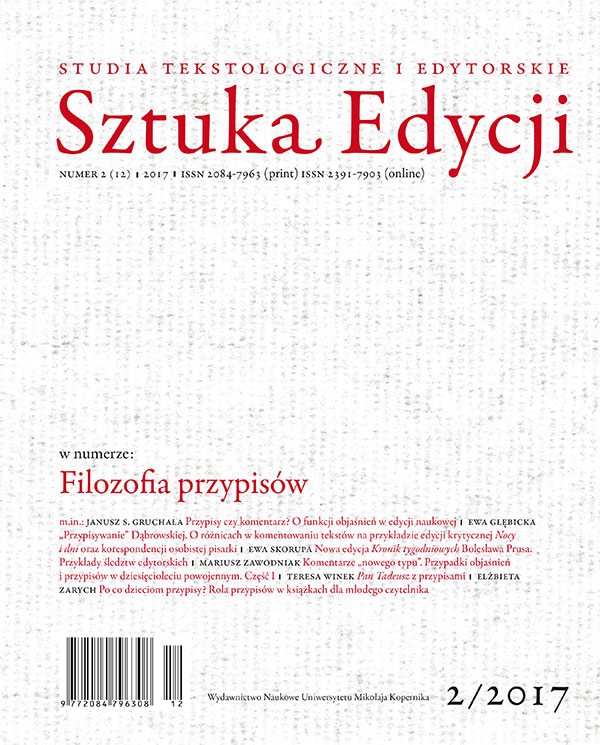Pan Tadeusz with footnotes
DOI:
https://doi.org/10.12775/SE.2017.0022Keywords
history of academic editorship, editorship by Wilhelm Bruchnalski, Stanisław Pigoń, Zofia Stefanowska, Zbigniew Jerzy Nowak, Pan TadeuszAbstract
In subject literature devoted to footnotes, attention has been paid primarily to the practical aspects of an editor’s work on factual comment; the historical aspect of the matter has provoked little interest of literary scholars. However, even a superficial glimpse at the footnotes of a single literary work serves as evidence that a factual comment is at times a consequence of various tendencies, not only editorial, but also the ones dominant literary and cultural life. In the article, we shall analyze them on the example of the editions with the richest editorial history, namely Pan Tadeusz. The analysis includes the editions by Macierz Polska, published in Lvov from the 80s of the 19th century till the First World War, with total circulation of two hundred thousand, dedicated to a mass reader. The second group is the narrative poem’s edition by Stanisław Pigoń as a part of “National Library” series, with an equal number of reissues and a wide address to readers. The context of those editions is the elaboration prepared by Zofia Stefanowska for the “National Library” series, as well as the last major edition of the narrative poem as Anniversary Edition of collected works by Mickiewicz. The background for the analysis is relevant editorial statements of theoretical nature by: Roman Pilat, Wilhelm Bruchnalski, Konrad Górski, which have shaped the practice of Polish editors in the 19th and 20th century, and scarce reviews dealing with the phenomenon of subtitles. The analyses lead to the conclusion that the volume of explanations to the narrative poem is constantly growing in quantitative terms, and that the attempts to verify their informative content do not always contribute positively to the understanding of the poem’s represented world and its artistic values.
References
Bruchnalski W., 1923, Próba kanonu wydawniczego w zastosowaniu do zbiorowej edycji „Dzieł wszystkich” Mickiewicza, „Pamiętnik Literacki”.
Cybulski R., 1972, Józef Zawadzki – księgarz, drukarz, wydawca, Wrocław.
Górski K., 1926, [dział] Recenzje, „Ruch Literacki”, nr 1.
Górski K., 1956, Sztuka edytorska. Zarys teorii, Warszawa.
Kronika życia i twórczości Mickiewicza, 1957, t. 1: Lata 1798–1824, oprac. M. Dernałowicz, K. Kostenicz i Z. Makowiecka, Warszawa.
Kridl M, 1925, [dział] Kronika, „Przegląd Warszawski”, t. 4.
Markiewicz M., 2004, O cytatach i przypisach, Kraków.
Mazurkowa B., 1993, Literacka rama wydawnicza dzieł Franciszka Dionizego Kniaźnina (na tle porównawczym), Katowice.
Mickiewicz A., 1913, Pan Tadeusz, czyli Ostatni zajazd na Litwie. Historia szlachecka z 1811 i 1812 r. w dwunastu księgach, wierszem, [oprac. W. Bruchnalski], Lwów.
Mickiewicz A., 1925, Pan Tadeusz, czyli Ostatni zajazd na Litwie. Historia szlachecka z roku 1811 i 1812. We dwunastu księgach wierszem, oprac. S. Pigoń, Kraków.
Mickiewicz A., 1957, Pan Tadeusz, czyli Ostatni zajazd na Litwie. Historia szlachecka z r. 1811 i 1812. We dwunastu księgach wierszem, oprac. Z. Stefanowska, wyd. 2, Wrocław.
Mickiewicz A., 1995, Dzieła, t. 4: Pan Tadeusz, czyli Ostatni zajazd na Litwie. Historia szlachecka z r. 1811 i 1812 we dwunastu księgach wierszem, oprac. Z. J. Nowak, Warszawa.
Pilat R., 1886, Jak należy wydawać dzieła polskich pisarzów XVI i XVII w.?, „Archiwum do Dziejów Literatury i Oświaty w Polsce”, t. 5–6: Pamiętnik Zjazdu Historyczno-Literackiego imienia Jana Kochanowskiego.
Stefanowska Z., 1979, Pamiętnik domowy w „Panu Tadeuszu”, w: Mickiewicz. Sympozjum w Katolickim Uniwersytecie Lubelskim, Lublin.
Szperacz [M. Danilewicz], 1959, Ładunek powietrza soplicowskiego, „Wiadomości” (Londyn), nr 17.
Tazbir J., 1997, Edytorskie potknięcia, Gdańsk.
Zahorska A., 1925, [dział] Przegląd piśmiennictwa, „Przegląd Powszechny”, t. 4.
Downloads
Published
How to Cite
Issue
Section
Stats
Number of views and downloads: 1099
Number of citations: 0



